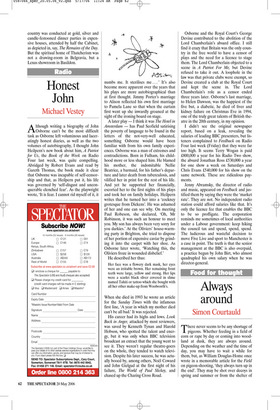Walking on eggshells
Simon Hoggart
Iwent to train in Manchester a year or so after the Moors murders, and they continued to hang over the city like an oldfashioned smog, sickening and inescapable. Reporters who had covered the trial in Chester and heard the tape of Lesley Ann Downey pleading for mercy and begging for her mother said that they used to lie awake at night hearing the little girl’s screams. The sense of a horror that existed on the fringe of normal life, yet hovered unnervingly nearby, was made worse by the moors themselves. These are not the cosy landscapes of the Peak District but are desolate and displeasing; the kind of scenery you never see on the cover of a Beautiful Britain calendar. They tend to be repetitive and featureless, and this made it hard for the police to find the victims’ graves even with the help of Hindley’s and Brady’s gloating photographs — one scene looks very like another.
See No Evil: The Moors Murders (ITV, Sunday and Monday) caught this sense of the banal co-existing with the terrible in its first shots, when a dark cloud rolling over moorland faded to Herman’s Hermits singing ‘I’m Into Something Good’. The chirpy, optimistic song worked as an ironic foretaste of the horrors to come. Except there were no horrors. The production oozed tastefulness. The sound of the producers walking on eggshells was almost deafening. It had been made with the cooperation of the victims’ families and in a way it served as a memorial to all five of them, an effect heightened at the end of part two when pictures of them all appeared, like the photos on Italian gravestones. This increased the poignancy as we realised that these innocents would, had they lived, have been middle-aged by now, fretting about their children’s late return from the market — even their grandchildren.
Of course, it would have been unspeakable, inconceivable, to show the children being tortured and murdered. It would probably have been too emotionally overwhelming for us even to have seen Myra Hindley picking one of them up and taking them to her car. The only violence at all came in part one, when Brady hacked at their last victim with an axe, but he was almost a grown man, and the act was shown blurred in red light, as stylised as the shower scene in Psycho. The result was that there was little to show us how Brady became the monster he was; Sean Harris played him as something of an oddball, the kind of bloke you avoid at office parties, but nobody really worrying. Something terrible happened to Myra, a warm and affectionate person who cuddled her little sister and wept for her dead niece, but we never got the remotest idea what it was. As the Lesley Ann Downey tape proved, Hindley was an enthusiastic assistant at the crimes, but why? In the end, instead of saying, ‘Now I understand what happened,’ your response can only be, ‘Well, who’d have thought it?’ See No Evil wasn’t really about the murders, but about the lives of people caught up in them — Myra’s sister Maureen, her husband David, who witnessed the last murder and told the police, but was unfairly believed locally to be implicated in all the killings, and the policeman who fought against bureaucracy to find the bodies and bring some shreds of comfort to the children’s families. The publicity showed Maxine Peake as Myra, in that familiar glowering pose which embodied the woman to us all for nearly 40 years, but in a way she and Brady were marginal figures in the drama. This was not about the Moors murders but about people who knew the Moors murderers, a different thing, so the effect was of watching an episode of Coronation Street in which all the events that matter are taking place offscreen. I see no way around this problem except not to make the programme in the first place.
The Line of Beauty (BBC2, Wednesday) was Brideshead Revisited for gays, right down to the wealthy family, the grand townhouse (Brideshead itself relocated in London), the kindly mother and the damaged sister. Andrew Davies, who adapted Alan Hollinghurst’s novel, loves to get plenty of sex into his shows, and since under the present social dispensation, gay sex is thoroughly acceptable, that means lots and lots of sex. Maurice Bowra famously remarked that buggery was invented to fill the awkward hour between Evensong and cocktails, though in this show it fills just about any available moment.
What puzzled me was the notion that in the Thatcher years the real business of the country was conducted at gold, silver and candle-festooned dinner parties in expensive houses, attended by half the Cabinet, as depicted in, say, The Remains of the Day. But the spiritual home of Thatcherism was not a drawing-room in Belgravia, but a Lexus showroom in Basildon.



















































































 Previous page
Previous page